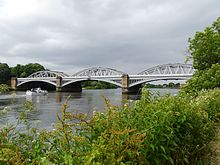Barnes Railway Bridge
| Barnes Railway Bridge | |
|---|---|

The current bridge showing the Locke span
|
|
| Carries | Railway Pedestrians |
| Crosses | River Thames |
| Locale | London, England |
| Heritage status | Grade II listed structure |
| Characteristics | |
| Design | Truss arch bridge |
| History | |
| Opened | 1895 |
Barnes Railway Bridge is a Grade II listed railway bridge in the London Borough of Richmond upon Thames and the London Borough of Hounslow. It crosses the River Thames in London in a northwest to southeast direction at Barnes. It carries the South West Trains Hounslow Loop Line, and lies between Barnes Bridge and Chiswick stations. It can also be crossed on foot, and is one of only two bridges in London to combine pedestrian and rail use; the other one being Fulham Railway Bridge.
The original bridge at this location was built in 1849 to a design by Joseph Locke and looked very similar to the original Richmond Railway Bridge which he also designed.
The replacement bridge, designed by Edward Andrews, is three spans of wrought iron bow string girders carrying two railway tracks. The construction work was carried out by Head Wrightson on behalf of the London & South Western Railway and was completed in 1895. The original Locke span still stands unused on the upstream side.
The bridge was given protection as a Grade II listed structure in 1983.
Barnes Bridge is also a landmark often quoted for the Oxford and Cambridge Boat Race, because it is suggested that whichever crew is ahead at this point will win the race. In 2003 the crews were in almost equal position approaching the bridge and Oxford ultimately won the race by just one foot.
The first Barnes Bridge, c. 1849
...
Wikipedia
